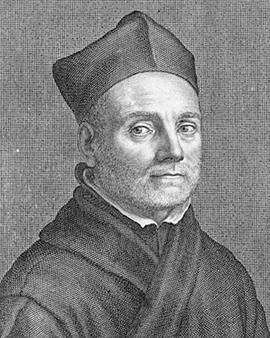Deep in the bowels of the city of Rome, in the heart of the ancient Collegium Romanum, unfolded the spiritual panorama of Athanasius Kircher - a German Jesuit and polymath who was born on May 2, 1602 in Geisa, in the Hochstift Fulda. Truly, Kircher was not only a man of his time, but also of its visions and miracles. Inscribed in the shadow texts of his day, Friedrich Kittler praised him as "the Pope's scientific firebrand," a preserver of knowledge and a protector of science. At the heart of the Renaissance, Kircher asserted himself with unprecedented monographs dealing with Egyptology, geology, medicine, mathematics, and music theory. His motto, In uno omnia (In One All), sums up the totality of his scientific curiosity and also reflects the spirit of our times and the perfection of reproduction of art prints as we pursue it.
At first glance, the biography of Athanasius Kircher may appear as a simple chronology of his life. But behind each date lies a far-reaching story full of science, culture and fascination. When he joined the Jesuit order on October 2, 1618, he began to study philosophy and theology, opening the first chapter of his remarkable life. His journey took him through the turbulence of the Thirty Years' War and to the halls of the Pontifical University of Avignon in France. In 1633 he was offered the opportunity to succeed Johannes Kepler, but fate had other plans and led him instead to Rome to the Collegium Romanum. Here he realized himself in a variety of disciplines and worked as a professor of mathematics, physics and oriental languages. But his insatiable curiosity also led him on research trips outside the university, for example to Sicily, where he climbed the Lipari Islands and Mount Etna.
In the second period of his life, which he devoted to science, Kircher realized a variety of works ranging from mathematics, physics and chemistry to geography, geology, astronomy, biology, medicine, music, languages, philology and history. His publications are a wealth of information and reflect his profound fascination with space, life, and the human experience. His impressive book Magnes (1641), for example, which dealt primarily with magnetism, spans a wide range and opens discussions on topics such as gravitation and even love. Perhaps his best-known work, the Oedipus Aegyptiacus (1652), is a broad study of Egyptology and comparative religion that brings to life the splendor and complexity of ancient Egypt. His contribution to scholarship and his dedication to the beauty and precision of Egyptian art and culture are aspects we value most in our own pursuit of perfection in the reproduction of fine art prints. Kircher, who died in Rome on November 27, 1680, leaves a legacy that reflects both his capacity for depth and variety in his scientific investigations and his appreciation of art. He was a man whose curiosity and passion enabled him to expand the frontiers of knowledge of his time. Today, we live on his legacy by bringing his work and love of art to life in our art prints, making his beauty and knowledge accessible to future generations.
×





.jpg)
.jpg)
_(bw_photo)_-_(MeisterDrucke-35353).jpg)
_(bw_photo)_-_(MeisterDrucke-35353).jpg)
_projects_the_image_of_a_man_burning_in_hell_-_(_-_(MeisterDrucke-924521).jpg)
_projects_the_image_of_a_man_burning_in_hell_-_(_-_(MeisterDrucke-924521).jpg)
.jpg)
.jpg)
.jpg)
.jpg)
.jpg)
.jpg)
.jpg)
.jpg)
.jpg)
.jpg)
.jpg)
.jpg)
.jpg)
.jpg)
.jpg)
.jpg)
.jpg)
.jpg)
.jpg)
.jpg)
.jpg)
.jpg)
.jpg)
.jpg)
.jpg)
.jpg)
.jpg)
.jpg)
.jpg)
.jpg)
.jpg)
.jpg)
.jpg)
.jpg)
.jpg)
.jpg)
.jpg)
.jpg)
.jpg)
.jpg)
_philosopher_Pythagorician_-_(MeisterDrucke-987130).jpg)
_philosopher_Pythagorician_-_(MeisterDrucke-987130).jpg)
.jpg)
.jpg)
.jpg)
.jpg)
.jpg)
.jpg)
_at_the_entrance_to_the_port_-_in_Turri_-_(MeisterDrucke-949462).jpg)
_at_the_entrance_to_the_port_-_in_Turri_-_(MeisterDrucke-949462).jpg)
.jpg)
.jpg)
.jpg)
.jpg)
.jpg)
.jpg)
.jpg)
.jpg)
.jpg)
.jpg)
.jpg)
.jpg)
_engraving_from_China_monuments_-_(MeisterDrucke-1464576).jpg)
_engraving_from_China_monuments_-_(MeisterDrucke-1464576).jpg)
.jpg)
.jpg)
_flies_a_wooden_dove_Engraving_from_Mundus_Subte_-_(MeisterDrucke-1024010).jpg)
_flies_a_wooden_dove_Engraving_from_Mundus_Subte_-_(MeisterDrucke-1024010).jpg)
_Italian_Jesuite_and_Paul_Ly_great_propagator_of_-_(MeisterDrucke-1003512).jpg)
_Italian_Jesuite_and_Paul_Ly_great_propagator_of_-_(MeisterDrucke-1003512).jpg)
.jpg)
.jpg)
.jpg)
.jpg)
.jpg)
.jpg)
.jpg)
.jpg)
.jpg)
.jpg)
.jpg)
.jpg)
.jpg)
.jpg)
.jpg)
.jpg)
.jpg)
.jpg)
.jpg)
.jpg)
.jpg)
.jpg)
.jpg)
.jpg)
.jpg)
.jpg)
.jpg)
.jpg)
.jpg)
.jpg)
.jpg)
.jpg)
_and_Matteo_Ricci_(right)_in_Chinese_Mandarin_costume_frontisp_-_(MeisterDrucke-1000974).jpg)
_and_Matteo_Ricci_(right)_in_Chinese_Mandarin_costume_frontisp_-_(MeisterDrucke-1000974).jpg)
.jpg)
.jpg)
.jpg)
.jpg)
.jpg)
.jpg)
.jpg)
.jpg)
.jpg)
.jpg)
.jpg)
.jpg)
.jpg)
.jpg)
.jpg)
.jpg)
.jpg)
.jpg)
.jpg)
.jpg)
.jpg)
.jpg)
.jpg)
.jpg)
.jpg)
.jpg)
_(1601-1680_-_(MeisterDrucke-932008).jpg)
_(1601-1680_-_(MeisterDrucke-932008).jpg)
_predecessor_of_Ferdinand_Verbiest_-_(MeisterDrucke-1094416).jpg)
_predecessor_of_Ferdinand_Verbiest_-_(MeisterDrucke-1094416).jpg)
.jpg)
.jpg)
.jpg)
.jpg)
.jpg)
.jpg)
.jpg)
.jpg)
_-_(MeisterDrucke-990590).jpg)
_-_(MeisterDrucke-990590).jpg)
.jpg)
.jpg)
.jpg)
.jpg)
.jpg)
.jpg)
.jpg)
.jpg)
.jpg)
.jpg)
.jpg)
.jpg)
.jpg)
.jpg)
.jpg)
.jpg)
.jpg)
.jpg)
.jpg)
.jpg)
.jpg)
.jpg)
.jpg)
.jpg)
.jpg)
.jpg)
.jpg)
.jpg)
.jpg)
.jpg)
.jpg)
.jpg)
.jpg)
.jpg)
.jpg)
.jpg)
.jpg)
.jpg)
.jpg)
.jpg)
.jpg)
.jpg)
.jpg)
.jpg)
.jpg)
.jpg)
.jpg)
.jpg)
.jpg)
.jpg)






